Mayor’s Office of Nightlife Fails First Big Test
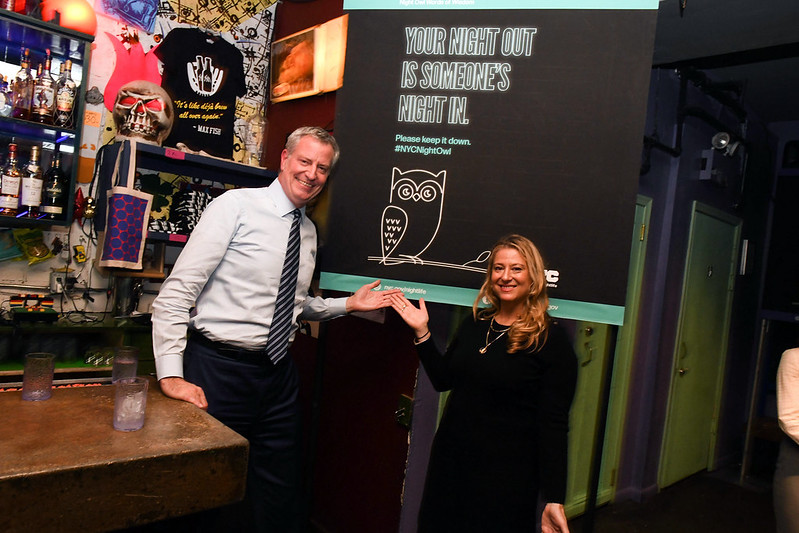
Mayor de Blasio and nightlife czar Ariel Palitz (photo: Ed Reed/Mayoral Photo Office)
Imagine living in a neighborhood where drunken people are screaming outside your apartment until 5 a.m. (you may not have to if you live in certain parts of New York City). Imagine trying to sleep when your bed shakes from the music playing in the bar three floors below. Imagine waking past empty storefronts that used to be vibrant small businesses. Imagine stepping out to meet friends for a cup of coffee on a crisp fall morning to find vomit on your front stoop. Again.
Now imagine, you’ve spent years fruitlessly asking elected leaders for help. In this reality — a reality shared by tens of thousands of New Yorkers — you might be buoyed by the recent news from the mayor that a solution has finally arrived. Unfortunately you’re about to be disappointed.
Mayor Bill de Blasio and Ariel Palitz, his choice to run the relatively new Mayor’s Office of Nightlife, are congratulating themselves on an initiative to alleviate traffic congestion, trash, and noise in a part of the Lower East Side that has become known as “Hell’s Square” since its transformation into a raucous nightlife destination.
This initiative is a result, in part, of the efforts of New York City residents to convince elected leaders to enact and enforce common-sense liquor laws and to address the trend of neighborhoods like the Lower East Side becoming oversaturated with bars to the point that they become unsafe, unbearable for residents, and nonviable for small businesses.
Formed two years ago, the Office of Nightlife was created to act as a liaison between the city and stakeholders in the nightlife economy. Nightlife is a complex issue where the needs of bar owners, large nightlife operators, landlords, and residents are frequently at odds.
To better understand these issues, Palitz conducted a listening tour in 2018 that consisted of five town halls (one in each borough) where stakeholders were invited to present problems and concerns, as well as ideas and solutions. The initiative in Hell’s Square is apparently a result of information gathered from those listening events. I say apparently because it was announced with no discernible effort to notify residents or community organizations, and without any explanation of the underlying strategy.
For residents concerned about the impact of oversaturation, this might seem worrisome enough. But there’s something far more troubling brewing in the Office of Nightlife: bias, bad faith, and hypocrisy.
Let’s start with the Economic Impact Study (EIS) commissioned by the Mayor’s Office of Media and Entertainment. This report speaks prominently of the positive impact nightlife has on the economy, but the study is egregious in its omissions and appears to have been produced to achieve a preconceived outcome favorable to the liquor industry. It is not a balanced study that examines the full impact of nightlife holistically.
While the EIS thoroughly examines direct and ancillary income generated from nightlife, it fails to explore direct and ancillary costs with equal vigor. For example, a graphic included in the EIS indicates that of the 317 million taxi rides in New York City in 2017, 101 million (32%) are attributable to nightlife.
The authors of the EIS included this chart to demonstrate the economic benefit of nightlife on the taxi industry, but they make no mention of the impact on air quality, pollution, health, policing, road repair, and other costs associated with 100 million cab rides. Nor do they discuss the potential impact of 100 million cab rides on the mayor’s Vision Zero street safety campaign. The omission of any risk or cost analysis associated with nightlife has to have been purposeful and is evidence of highly biased reporting meant to pull the wool over city residents’ eyes.
Another Office of Nightlife initiative — a mediation program launched to resolve challenges such as sound-related disputes between venues and residents — is not only redundant, it exhibits a stunning ignorance of the issues.
Residents can already go to their Community Boards for mediation, but before they do, they must gather supporting evidence. The entire burden of policing, documenting, and reporting on violations falls upon residents, which places an unreasonable burden on thousands of working families who may lose income if they take time off from work. There is also no enforcement arm to ensure nightlife venues adhere to any mediation agreements.
Worse still, there is no publicly available information detailing the number of mediations the Office of Nightlife has conducted, where they were conducted, who was in attendance, who mediated, or the outcomes of those mediations.
This creates serious questions about the efficacy, transparency, and accountability of how taxpayer dollars are being spent in service of the Office of Nightlife’s mission.
In the year since the listening sessions occurred, Palitz has failed to make publicly available any research or analysis from the events. As a result, stakeholders can only speculate as to why Palitz (and de Blasio) is prioritizing certain efforts against the many other issues raised during the listening events.
For example, members of Neighborhoods United — an organization formed by residents and community leaders from across the five boroughs of New York City to advocate for a balanced approach to nightlife — presented numerous concerns as well as potential solutions both at Palitz’s listening tour town halls and to the Nightlife Advisory Board directly.
Top concerns included increases in violent crime, fighting, vandalism, traffic congestion, excessive noise, cultural appropriation, loss of jobs, over-serving alcohol, lack of enforcement, and skyrocketing rents that drive out other small businesses — and the correspondence of these issues to liquor license oversaturation.
We also provided solutions including:
The strict enforcement of the 500 Foot Rule, a law that is meant to limit the number of liquor licenses within a 500 foot radius.
Increasing the number of inspectors and the frequency of their visits (similar to the system in place for the restaurant industry).
A publicly-accessible database of all bars detailing the legally-binding stipulations associated with their licenses, as well as complaints lodged against them.
And while Palitz’s initiative in Hell’s Square and other efforts are welcome, they’re bandaids. They do nothing to address the underlying issues that persist across the city. Similar saturation zones are forming in neighborhoods such as Hell’s Kitchen, East Village, Innwood, and Williamsburg, and spreading into rapidly gentrifying sections of the Bronx and Queens.
And this lack of transparency does more than squelch accountability — it also impedes the development of innovative solutions.
On October 27, the City Council passed a new system for handling commercial trash, which is half the city’s waste. The legislation was the result of looking at the issue holistically, considers the entire trash ecosystem, was created by collecting and reviewing data, and factors in the needs of multiple stakeholders. The written report details how the plan will save the city money, decrease pollution, and improve the health, safety, and welfare of workers and residents.
By law the Office of Nightlife must release an annual report on its activities, the first of which was due 18 months after the law was enacted September 19, 2019 -- making the first report now nine months overdue --- but based on the biased and incomplete reporting in the Economic Impact Study, the redundant and undocumented current efforts, and ignorance at the issues facing New Yorkers living in high-density neighborhoods, residents are concerned that whenever it is released the Office of Nightlife’s report will be a bad faith document that misrepresents the urgent concerns of residents, vastly underrepresents the direct and ancillary costs associated with the nightlife industry, and recommends solutions that fail to address the underlying, systemic issues.
After the announcement of the Hell’s Square initiative we thanked Palitz for her efforts, and asked her to explain the process. She ignored our questions, saying only that she “hears us.”
What’s clear from her lack of transparency, lack of communication, lack of any visible strategy, and ignorance of the issues faced by residents, is that Palitz and de Blasio haven’t listened.
Residents demand the Office of Nightlife immediately make public all data and results from current initiatives and announce a date for a public presentation of Palitz’s comprehensive strategy and the data that supports it.
***
David C. Stuart, on behalf of Neighborhoods United. On Twitter @5BorosUnitedNYC.
***
Have an op-ed idea or submission for Gotham Gazette? Email This email address is being protected from spambots. You need JavaScript enabled to view it.
New York's Ambitious Climate Law Hangs in the Balance
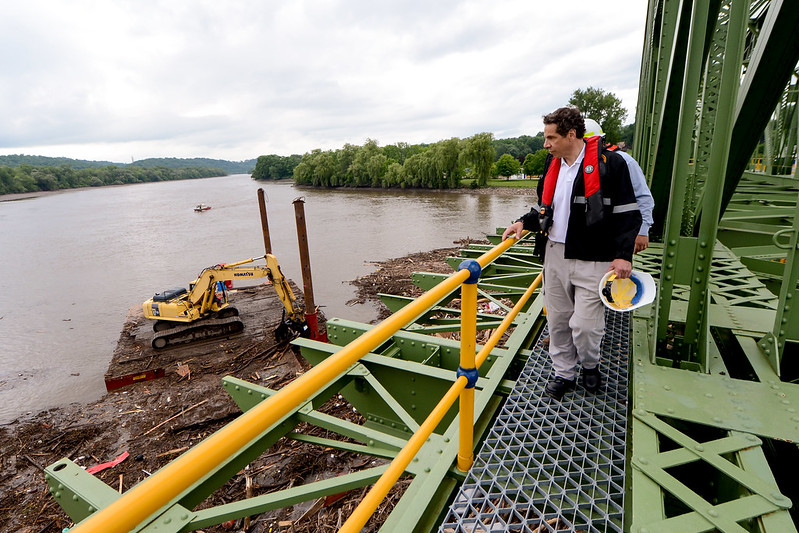
(photo: governor's office)
This spring, thanks to the tireless work of grassroots organizers, New York State took the first step towards tackling the climate crisis. The Legislature passed, and the governor signed the Climate Leadership and Community Protection Act, which sets binding mandates to get New York off of fossil fuels and directs much-needed support to communities hit first and worst by the climate crisis.
The CLCPA is a landmark piece of legislation. It’s been called “the most ambitious climate target in the country” and New York’s “best hope for meaningful climate action.” But now, it’s in danger of being delayed. With only 10 years left for meaningful action before we lock in catastrophe, New York must begin to implement its new climate law now.
Governor Cuomo is stalling progress on climate action by not signing a related piece of legislation, which establishes an Environmental Justice Advisory Council to help the state center the needs of frontline communities in its climate and energy planning.
Because of an obscure clause in the legislative language, the CLCPA and the Environmental Justice Bill go into effect at the same time, and the Environmental Justice Bill will become law on January 1 of the year after it’s signed. It’s now mid-December, and Governor Cuomo still hasn’t signed the Environmental Justice Bill. If we wait more than a few weeks, we risk delaying the CLCPA by at least a year – cutting into our already short timeframe for slashing our emissions and investing in a Just Transition for frontline communities.
Despite producing fewer greenhouse gas emissions than the rich, low income-communities and communities of color are hit first and worst by the climate crisis. Too often, climate solutions, including those put forth by traditional and mainstream environmental groups, ignore this reality. We should use all the tools at our disposal to ensure those most impacted by climate change lead in developing the solutions.
The Environmental Justice Bill and the equity provisions of the CLCPA help New York be firm in its commitment to environmental justice. Between these two pieces of legislation, we have mandates to get New York off of fossil fuels along the timeline recommended by the world’s leading climate scientists, invest in communities on the frontlines of the climate crisis, and create good, long-term, green jobs across the state. But unless the governor signs the Environmental Justice bill, neither will go into effect for another year.
The climate crisis is too threatening, and the consequences of inaction too large, for us to drag our feet. The Senate should deliver, and the governor should sign, the Environmental Justice Bill without delay.
***
Priya Mulgaonkar is Resiliency Planner at the New York City Environmental Justice Alliance. On Twitter @priyukli & @NYCEJAlliance.
***
Have an op-ed idea or submission for Gotham Gazette? Email This email address is being protected from spambots. You need JavaScript enabled to view it.
NYCHA Open Space: The Next City Park Frontier
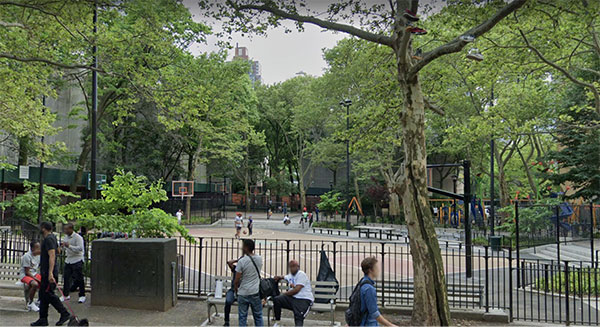
Samuel N. Bennerson 2nd Playground could be a model (Google, 2019)
New Yorkers have been building parks in the most unexpected places. Popular parks have risen over rotting piers on the waterfront; on an elevated and abandoned rail freight line; and even in the middle of busy traffic intersections in Times Square. Many skeptics doubted that anyone would want to sunbathe along the East River, eat a snack in the middle of Times Square, or walk on a rickety steel structure 30 feet above the streets. The skeptics were wrong. Millions have flocked to new spaces in strange places.
There is an even larger and more accessible reservoir of untapped space for new city parks: the thousands of acres of lawns and trees that surround NYCHA towers. NYCHA developments are often 70 or 80 percent open space; yet much of this open space feels unnecessarily isolated from vibrant avenues and neighborhoods.
The volume of land available for new parks within NYCHA, if redesigned as “activated” neighborhood parks, could have a transformative impact on the city’s quality of life.
The Regional Plan Association, for instance, in TIme to Act, has highlighted the potential: “There are several places where NYCHA open space and NYC Parks open space could be combined into a larger community asset managed by the Parks Department. This would allow NYCHA to benefit from the City, and the City to benefit from NYCHA.”
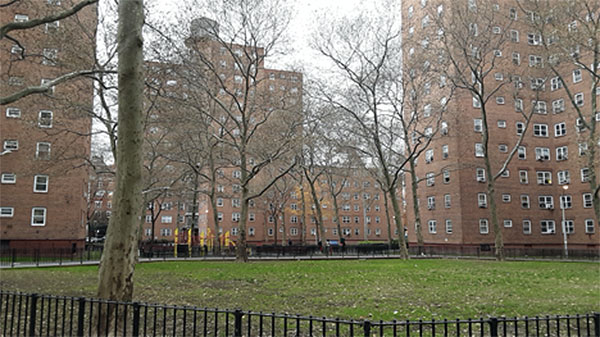
Johnson Houses, like most NYCHA projects, has open space and tree cover that reduces temperatures and encourages air circulation. But is this the best we can do for city or NYCHA residents? (photo by the author)
Good Intentions; Lost Promise
For NYCHA’s founding designers and administrators (in the 1930s), the space around towers served primarily as a conduit for air and light to resident apartments. Public housing was a powerful tool for attacking congested tenement neighborhoods; open spaces were an afterthought.
Landscape architects limited recreational uses to passively enjoyed greens with benches and small playgrounds for the little ones. Active recreational elements such as large ball courts or fields were added later and only sporadically under pressure from residents and recreation specialists. Parks Commissioner Robert Moses, in fact, lambasted NYCHA administrators for failing to provide enough active recreation; he made a point of putting a few NYC Parks adjoining, and sometimes inside, NYCHA superblocks.
When NYCHA projects were full of young families, and crime was low, kids and seniors lived an enthusiastic and reasonably successful outdoor life (from the 1930s to 1960s) on the grounds between the towers. In an era before air conditioning, summers were particularly active on NYCHA properties.
A changing city and society, however, undermined the original logic of providing such vast open spaces. Rising crime and gang territoriality cut into the liveliness of NYCHA outdoor spaces from the 1960s onwards; many concerned families kept their kids indoors for safety. Air conditioning and electronic entertainment kept children and families inside even when safety wasn’t an issue. Many green areas were poorly maintained or paved over as other maintenance priorities emerged. Neighbors stayed out due to fear, even when NYCHA spent millions on new play equipment, benches, paths, fences, and fountains.
The 710 playgrounds still run by NYCHA directly have been a sore point for managers. The pressure to maintain multiple play areas within a single development not only reduces the density of children on equipment (reducing the fun!), but demands a level of maintenance staffing NYCHA has struggled to maintain due to federal budget cuts. Nor does NYCHA have a recreation staff that can draw in non-NYCHA residents to events or activities.
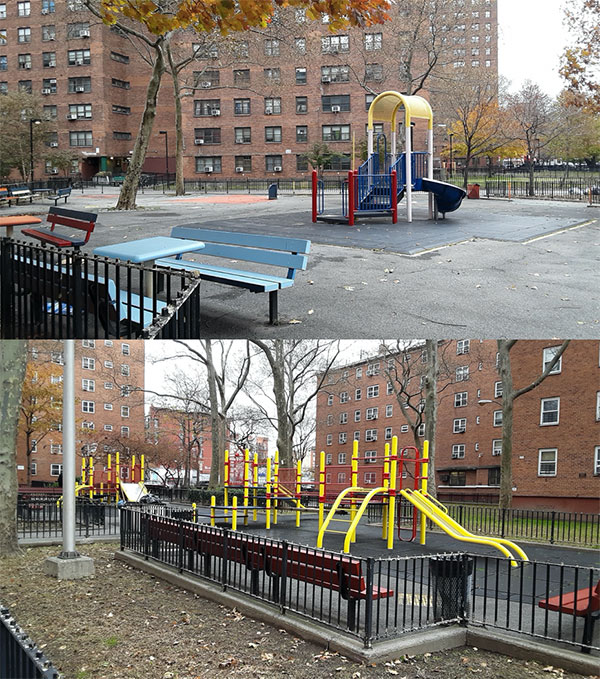
Typical underutilized playgrounds in East Harlem public housing projects. (photos by the author)
A City Parks Network in NYCHA: Building on a Tradition
There are solid reasons to believe that a new network of NYC Parks on NYCHA open spaces will be a success for the simple reason that many NYC Parks have thrived for decades in NYCHA settings.
The Samuel N. Bennerson 2nd Playground of Manhattan’s Amsterdam Houses, for instance, has been an NYC Park since it opened in 1949: “The property, three-quarters of an acre in extent, was acquired by the New York City Housing Authority and is for the families in the project and the residents of the surrounding congested community,” wrote the New York Times in 1949. The language of shared facilities -- between NYCHA and the surrounding community -- is reflected today in the edge location. The Parks Department started with playground equipment there and added basketball facilities in 1982.
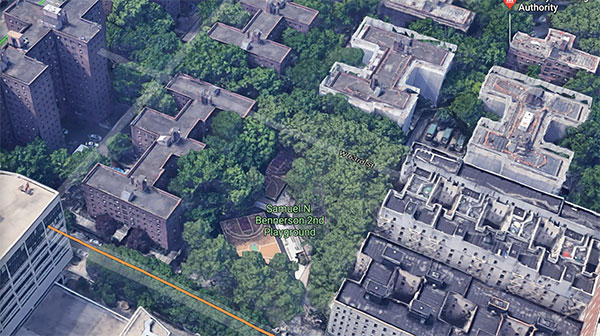
NYCHA buildings surround Bennerson on two sides, but the park fronts an active street that helps draw in outsiders. (Google)
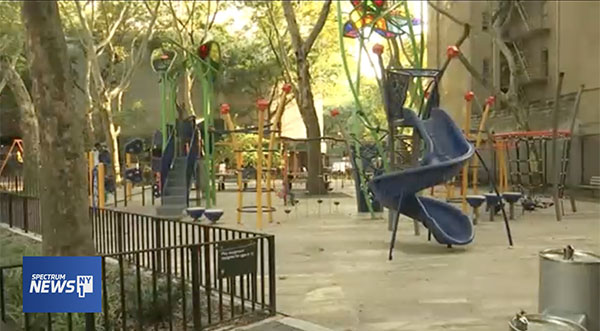
New Playground at Bennerson (NY1)
The Parks Department let Bennerson decline, but NYCHA residents and community leaders demanded upgrades. The park’s recent renovation was a multi-million-dollar project of former Upper West Side City Council Member Gale Brewer (now Manhattan Borough President) and her successor, Council Member Helen Rosenthal. Thanks to city capital funds, the park has been renovated to a high standard with two new basketball courts, a new playground, and cooling spray fountain. Community basketball programs thrive. Above all, the park fronts on a busy cross street and welcomes outsiders through signage and fun design elements.
To get a sense of the impressive, large-scale opportunities presented by NYCHA open spaces, consider Bushwick Houses. There, NYC Parks maintains a pool and playground within the Bushwick development in Brooklyn. The playground stretches along one edge of the development and provides an active, protected edge to the excellent pool complex deeper within the development. There is also a high-quality baseball diamond adjoining the pool.
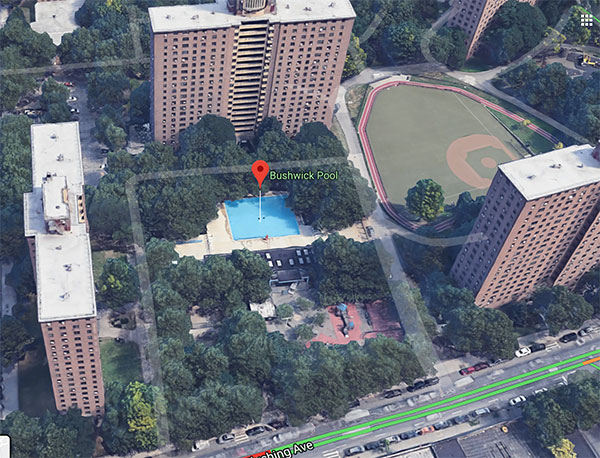
Bushwick pool, playground, and ball field all within a single NYCHA project
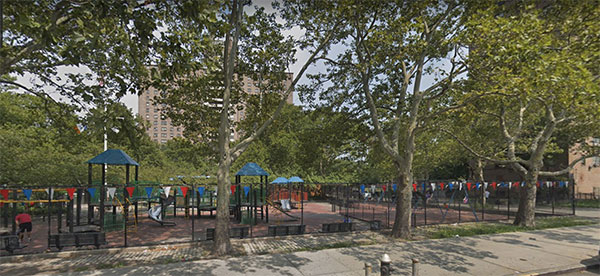
The Bushwick playground run by the Parks Department aligns with the street and community
Carving out new NYC Parks from the vast NYCHA domain, as these examples illustrate, represents a chance to reknit valuable open space into neighborhoods. The parcels at the edges of NYCHA projects, alongside active streets and sidewalks, stand a good chance of attracting neighbors because these edges feel (and often are) more secure. Adding new types of recreational options, and a NYC Parks label, will send a welcome message to surrounding communities. Many politicians also prefer to support projects of wider benefit: as a result, the parks run by the Parks Department are likely to be better maintained.
New Parks for the Next Generation of New Yorkers
Public open spaces suitable for parks are seemingly scarce in New York City. In 2016, for instance, the city spent $160 million to buy industrial land for a single new Williamsburg park. But city officials have overlooked a more abundant and lower cost source of parkland. NYCHA open spaces are flat, conveniently located for transit, and shovel ready.
NYCHA residents are also likely to support the effort because parks enhance livability. Adding NYC Parks to public housing, moreover, doesn’t preclude future infill, redevelopment, or RAD conversion: there is more than enough land for both new parks and a variety of redesign strategies.
Above all, upgrading selected NYCHA grounds to NYC Parks could be transformational for many neighborhoods lacking in community amenities. Parks could have comfort stations, small stores or kiosks, and for-profit enterprises like climbing walls that would enliven city living and help cover park maintenance. The many activities that animate the Brooklyn waterfront parks (and help defray their maintenance costs) are a great model. Just imagine climbing walls, rinks, small outdoor cafes, new pools, or other facilities that would enliven NYCHA grounds and surrounding neighborhoods.
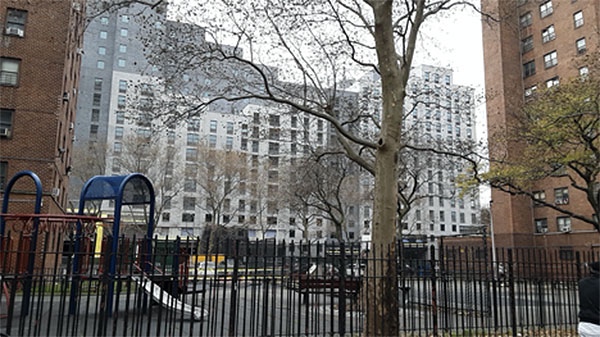
The grey building in the background is a densely developed new affordable housing project (The Carolina) next to NYCHA's Clinton Houses in East Harlem (photo by the author)
High-quality open spaces are needed more than ever as the city becomes more crowded with buildings and people. The new apartment towers sprouting near NYCHA towers, for instance, contain relatively small apartments and tiny courtyards. Some newcomers may venture into NYCHA projects, but they likely won’t feel welcome or inspired given the infrastructure; many more will trek a long way for a distant park or other neighborhood amenities. Wouldn’t it make sense to upgrade adjacent NYCHA open spaces to help meet the need for recreation on a community-wide basis? Of course it would.
***
Nicholas Dagen Bloom, Professor of Urban Policy and Planning, Hunter College is author of Public Housing That Worked, How States Shaped Postwar America: State Government and Urban Policy, and a co-curator of the HOUSING DENSITY show.
***
Have an op-ed idea or submission for Gotham Gazette? Email This email address is being protected from spambots. You need JavaScript enabled to view it.




